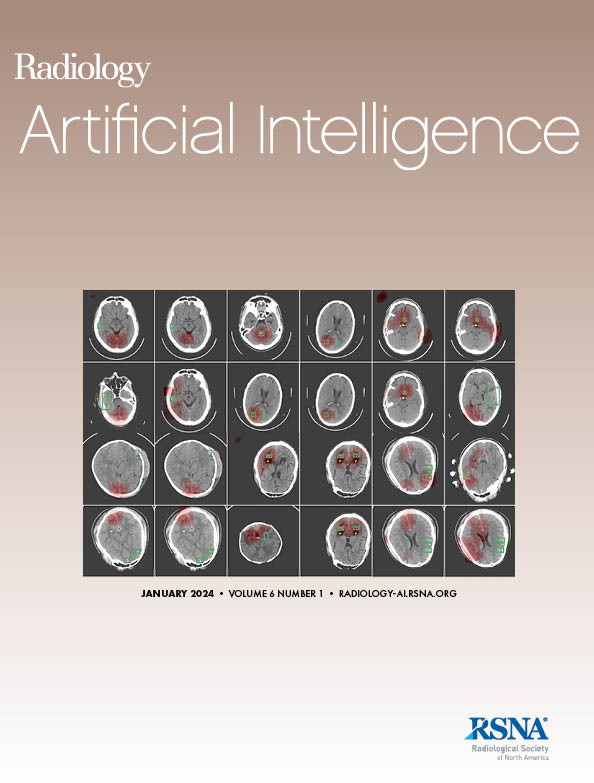Tianyu Tang, Ying Cui, Chunqiang Lu, Huiming Li, Jiaying Zhou, Xiaoyu Zhang, Yujie Zhou, Ying Zhang, Yi Zhang, Yuhao Xu, Yuefeng Li, Shenghong Ju
求助PDF
{"title":"评估深度学习多标签分割模型在脑卒中后MRI上量化急慢性脑损伤和预测预后的性能。","authors":"Tianyu Tang, Ying Cui, Chunqiang Lu, Huiming Li, Jiaying Zhou, Xiaoyu Zhang, Yujie Zhou, Ying Zhang, Yi Zhang, Yuhao Xu, Yuefeng Li, Shenghong Ju","doi":"10.1148/ryai.240072","DOIUrl":null,"url":null,"abstract":"<p><p>Purpose To develop and evaluate a multilabel deep learning network to identify and quantify acute and chronic brain lesions at multisequence MRI after acute ischemic stroke (AIS) and assess relationships between clinical and model-extracted radiologic features of the lesions and patient prognosis. Materials and Methods This retrospective study included patients with AIS from multiple centers, who experienced stroke onset between September 2008 and October 2022 and underwent MRI as well as thrombolytic therapy and/or treatment with antiplatelets or anticoagulants. A SegResNet-based deep learning model was developed to segment core infarcts and white matter hyperintensity (WMH) burdens on diffusion-weighted and fluid-attenuated inversion recovery images. The model was trained, validated, and tested with manual labels (260, 60, and 40 patients in each dataset, respectively). Radiologic features extracted from the model, including regional infarct size and periventricular and deep WMH volumes and cluster numbers, combined with clinical variables, were used to predict favorable versus unfavorable patient outcomes at 7 days (modified Rankin Scale [mRS] score). Mediation analyses explored associations between radiologic features and AIS outcomes within different treatment groups. Results A total of 1008 patients (mean age, 67.0 years ± 11.8 [SD]; 686 male, 322 female) were included. The training and validation dataset comprised 702 patients with AIS, and the two external testing datasets included 206 and 100 patients, respectively. The prognostic model combining clinical and radiologic features achieved areas under the receiver operating characteristic curve of 0.81 (95% CI: 0.74, 0.88) and 0.77 (95% CI: 0.68, 0.86) for predicting 7-day outcomes in the two external testing datasets, respectively. Mediation analyses revealed that deep WMH in patients treated with thrombolysis had a significant direct effect (17.7%, <i>P</i> = .01) and indirect effect (10.7%, <i>P</i> = .01) on unfavorable outcomes, as indicated by higher mRS scores, which was not observed in patients treated with antiplatelets and/or anticoagulants. Conclusion The proposed deep learning model quantitatively analyzed radiologic features of acute and chronic brain lesions, and the extracted radiologic features combined with clinical variables predicted short-term AIS outcomes. WMH burden, particularly deep WMH, emerged as a risk factor for poor outcomes in patients treated with thrombolysis. <b>Keywords:</b> MR-Diffusion Weighted Imaging, Thrombolysis, Head/Neck, Brain/Brain Stem, Stroke, Outcomes Analysis, Segmentation, Prognosis, Supervised Learning, Convolutional Neural Network (CNN), Support Vector Machines <i>Supplemental material is available for this article.</i> © RSNA, 2025.</p>","PeriodicalId":29787,"journal":{"name":"Radiology-Artificial Intelligence","volume":" ","pages":"e240072"},"PeriodicalIF":13.2000,"publicationDate":"2025-05-01","publicationTypes":"Journal Article","fieldsOfStudy":null,"isOpenAccess":false,"openAccessPdf":"","citationCount":"0","resultStr":"{\"title\":\"Evaluating Performance of a Deep Learning Multilabel Segmentation Model to Quantify Acute and Chronic Brain Lesions at MRI after Stroke and Predict Prognosis.\",\"authors\":\"Tianyu Tang, Ying Cui, Chunqiang Lu, Huiming Li, Jiaying Zhou, Xiaoyu Zhang, Yujie Zhou, Ying Zhang, Yi Zhang, Yuhao Xu, Yuefeng Li, Shenghong Ju\",\"doi\":\"10.1148/ryai.240072\",\"DOIUrl\":null,\"url\":null,\"abstract\":\"<p><p>Purpose To develop and evaluate a multilabel deep learning network to identify and quantify acute and chronic brain lesions at multisequence MRI after acute ischemic stroke (AIS) and assess relationships between clinical and model-extracted radiologic features of the lesions and patient prognosis. Materials and Methods This retrospective study included patients with AIS from multiple centers, who experienced stroke onset between September 2008 and October 2022 and underwent MRI as well as thrombolytic therapy and/or treatment with antiplatelets or anticoagulants. A SegResNet-based deep learning model was developed to segment core infarcts and white matter hyperintensity (WMH) burdens on diffusion-weighted and fluid-attenuated inversion recovery images. The model was trained, validated, and tested with manual labels (260, 60, and 40 patients in each dataset, respectively). Radiologic features extracted from the model, including regional infarct size and periventricular and deep WMH volumes and cluster numbers, combined with clinical variables, were used to predict favorable versus unfavorable patient outcomes at 7 days (modified Rankin Scale [mRS] score). Mediation analyses explored associations between radiologic features and AIS outcomes within different treatment groups. Results A total of 1008 patients (mean age, 67.0 years ± 11.8 [SD]; 686 male, 322 female) were included. The training and validation dataset comprised 702 patients with AIS, and the two external testing datasets included 206 and 100 patients, respectively. The prognostic model combining clinical and radiologic features achieved areas under the receiver operating characteristic curve of 0.81 (95% CI: 0.74, 0.88) and 0.77 (95% CI: 0.68, 0.86) for predicting 7-day outcomes in the two external testing datasets, respectively. Mediation analyses revealed that deep WMH in patients treated with thrombolysis had a significant direct effect (17.7%, <i>P</i> = .01) and indirect effect (10.7%, <i>P</i> = .01) on unfavorable outcomes, as indicated by higher mRS scores, which was not observed in patients treated with antiplatelets and/or anticoagulants. Conclusion The proposed deep learning model quantitatively analyzed radiologic features of acute and chronic brain lesions, and the extracted radiologic features combined with clinical variables predicted short-term AIS outcomes. WMH burden, particularly deep WMH, emerged as a risk factor for poor outcomes in patients treated with thrombolysis. <b>Keywords:</b> MR-Diffusion Weighted Imaging, Thrombolysis, Head/Neck, Brain/Brain Stem, Stroke, Outcomes Analysis, Segmentation, Prognosis, Supervised Learning, Convolutional Neural Network (CNN), Support Vector Machines <i>Supplemental material is available for this article.</i> © RSNA, 2025.</p>\",\"PeriodicalId\":29787,\"journal\":{\"name\":\"Radiology-Artificial Intelligence\",\"volume\":\" \",\"pages\":\"e240072\"},\"PeriodicalIF\":13.2000,\"publicationDate\":\"2025-05-01\",\"publicationTypes\":\"Journal Article\",\"fieldsOfStudy\":null,\"isOpenAccess\":false,\"openAccessPdf\":\"\",\"citationCount\":\"0\",\"resultStr\":null,\"platform\":\"Semanticscholar\",\"paperid\":null,\"PeriodicalName\":\"Radiology-Artificial Intelligence\",\"FirstCategoryId\":\"1085\",\"ListUrlMain\":\"https://doi.org/10.1148/ryai.240072\",\"RegionNum\":0,\"RegionCategory\":null,\"ArticlePicture\":[],\"TitleCN\":null,\"AbstractTextCN\":null,\"PMCID\":null,\"EPubDate\":\"\",\"PubModel\":\"\",\"JCR\":\"Q1\",\"JCRName\":\"COMPUTER SCIENCE, ARTIFICIAL INTELLIGENCE\",\"Score\":null,\"Total\":0}","platform":"Semanticscholar","paperid":null,"PeriodicalName":"Radiology-Artificial Intelligence","FirstCategoryId":"1085","ListUrlMain":"https://doi.org/10.1148/ryai.240072","RegionNum":0,"RegionCategory":null,"ArticlePicture":[],"TitleCN":null,"AbstractTextCN":null,"PMCID":null,"EPubDate":"","PubModel":"","JCR":"Q1","JCRName":"COMPUTER SCIENCE, ARTIFICIAL INTELLIGENCE","Score":null,"Total":0}
引用次数: 0
引用
批量引用

 求助内容:
求助内容: 应助结果提醒方式:
应助结果提醒方式:


